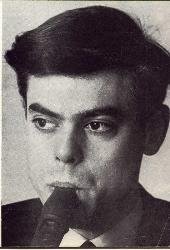There was a sober memorial service held at the Oude Kerk in Amsterdam on Tuesday [19 August 2014] for Frans Brüggen, whom his family described as a “magician” on the funeral invitation.
By eleven o’clock, a long line had formed outside the church. About a thousand musicians and friends had gathered to pay their respects to Frans Brüggen, who had passed away the previous week. The appreciation for what he has done was almost palpable among those present.
At the front the church, the white coffin was surrounded by flowers. Brüggen’s wife, the art historian Machtelt Israëls, stood with Brüggen’s close friend Sieuwert Verster and two of Brüggen’s four daughters to accept condolences.
The ceremony began with Bach’s chorale prelude Erbarm dich mein which was played on the main organ. Verster who, with Brüggen, had led the Orchestra of the Eighteenth Century, was the first to speak. He quipped that Brüggen had said that there would be a great deal of interest in his memorial service. Laughter. He went on to say that Brüggen had had a “very rich life” and that what remains was a “Holy alliance” of the words, the memories and the music. “This is the source of energy which must now sustain us,” he said.
He recalled the last concert conducted by Brüggen, in May at the Hague Conservatory, with works by Rameau. “There was young talent, the old guard and an orchestra of middle-aged people all playing together. Frans enjoyed this hugely.”
Verster went on to try to identify the three pillars of Brüggen’s genius. “First, no one else understood as much about the very core of the music. Secondly, he knew how to create the ideal orchestra, with his Orchestra of the Eighteenth Century, bringing together musicians who loved to perform [this kind of] music to the highest possible standard. The third was that when he conducted, there was a kind of peace and constantly developing affection that existed, through which the essence of [real] music making became possible. “
A short news video (in Dutch) of the ceremony
With a nod to Brüggen’s infamous statement that every note of Mozart played by the Concertgebouw Orchestra was a lie [see here], Verster imagined that, if there is such a thing as heaven, or a another kind of meeting place, in which Brüggen, Bach, Mozart and many other composers could meet, that they would all praise Brüggen for his authentic performance practice.
Because Brüggen liked applause “an awful lot”, Verster asked the attendees to give the deceased one final round of applause. The Orchestra of the Eighteenth Century then played the understated chorale Von Gott will ich nicht lassen by Bach. Among others, Brüggen’s old friends, Kees Boeke and Walter van Hauwe, then performed on recorders.
[At the end,] Brüggen’s two oldest daughters, Laura and Alicia, spoke on behalf of the family, followed by Zephyr and Eos, his children with Machtelt Israëls. Finally, Brüggen’s wife spoke herself, and told us that the body of her husband would be committed to “fire and air,” in a private ceremony to be held “in the sand dunes by the sea”.
She gave the “last word” to a recording of the Pavane by Samuel Scheidt, performed by Brüggen and his orchestra.
Here is the original article (in Dutch) & photos of the ceremony
Please subscribe to this blog – in the top right corner – and receive notifications of new posts by e-mail.
Acknowledgments
Thanks are due to Jaco van der Knijff, who wrote the original article, which first appeared on 19 August 2014, and to the Editor of the Reformatorisch Dagblad for permission to translate and publish this piece.
Copyright © Jaco van der Knijff; Reformatorisch Dagblad 2014
© Semibrevity for this translation, 2014 All rights reserved


Leave a Reply